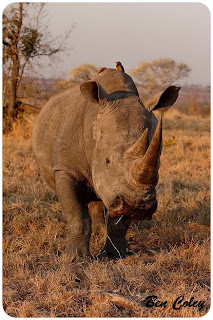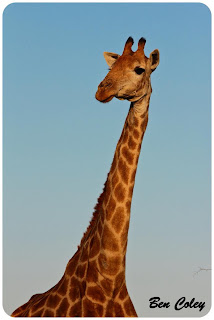Forgive me followers for I have sinned. It’s been 6 weeks since my last entry…
The last few weeks of life at Sabi Sabi have been incredibly busy, with the lodge running at near full capacity. Whilst this has given us a true understanding of sleep deprivation, it has allowed me to spend plenty of time in the field following the daily lives of our myriad of inhabitants. Spring has definitely arrived now and the temperature is getting hotter by the day. The knobthorns and tree wisterias are in full bloom and the bush is beginning to prepare itself for the coming resurrection, brought about by the impending rains. We have had one brief thunderstorm in the past 2 weeks and this is surely a precursor to the changing weather patterns in the days that follow. For now though, the game viewing is at its peak. September is one of the best times to visit the bush – the vegetation is low allowing maximum visibility and the animals need for water is at its greatest. Elephants have been making daily voyages to the watering hole in front of bush lodge and the warmer days have brought back some of our migratory birds. Yet more birds are beginning to moult their drab eclipse plumages and begin to grow their breeding colours as they prepare for the annual courtship displays.
 |
| Close up of one of the beauiful lioness in the southern pride |
No doubt a lot of you will be keen to catch up on the main players in our corner of paradise. We’ll start with the big news, and also the saddest, although it comes as no surprise to those of us witnessing the script unfolding. After weeks of running, the inevitable has finally caught up with the Southern Pride and one of their cubs has been lost to the wrath of the Kruger males. We watched perplexed as the males were seen fairly recently eating with and interacting with the cubs; leading us to think that perhaps the females’ promiscuous tendencies has been rewarded and that the males had been duped into believing that the cubs were theirs. However, it seems that the lure of food and potentially receptive females merely prolonged the confrontation that unfolded.
 |
| The 2 Kruger males contemplate the next move in their hostile take over |
 |
| One of the lucky ones takes advantage of high ground as they put distance between themselves and the males |
 |
| The lionesses stretching after a brief rest during their evacuation |
As is usually the way, we were not there to witness the act itself and many emotions were felt by all when the call came in that a dead cub had been seen close to where one of the males had been hiding. However, as the day continued, more evidence was discovered as to the course of events that had unfolded the night before. The other male was found with huge gashes on his back legs, no doubt inflicted by the females as they valiantly fought to save their offspring. To administer such wounds to a full grown male is not easy and evidence of this was seen later when the remaining females and cubs were found far away from the battlefield. It seems that the female with the floppy ear, known as Mandleve, had run distraction and sustained some nasty injuries to her paw. Although not a matriarchal society, our pride often looks to her, as the most experienced lioness, for guidance and it comes as no surprise that she was one adopting the role of protector. From the look of it, both parties will recover, as in the wild animals heal quickly – a necessary adaptation to ensure future survival. It seems losses on the prides’ side numbered only one and the rest of the pride was able to escape. Now that the males have entered the playing field however, the chances of survival for the remaining 9 seem slimmer than ever.
 |
| And then there were 9.... |
 |
| Display of motherly affection as pride reaffirms its social bonds |
 |
| Lioness reflected in the water at sunset |
This cycle we have also been afforded a rare glimpse of the wild dogs once more. Since the pups have started to mature they have been accompanying the adults on their ceaseless hunt. Their endless roaming in search of food to feed their voracious appetite brought them back to Sabi Sabi, even if only briefly. Those of you that have viewed wild dogs before will know that a sighting is chaotic as we try to keep a visual of them as they tear through the bush. This one was no different and when we finally caught up them, we managed to catch a glimpse of them finishing off their latest victim: a common duiker. With 6 adults and 6 pups, the duiker was finished off inside 10 minutes! The communal regurgitating of food followed, as did the playful social bonding that often follows a successful hunt resembling warriors celebrating a fruitful campaign. The following day they had disappeared and we wait with impatience for their future return.
 |
| The dogs playing together after their duiker kill |
 |
| Submissive behaviour being exhibited by a lower ranking dog |
Leopards, in my humble opinion, the most beautiful mammal walking the planet today, are in short supply at the moment. But our interpretation of the word ‘short’ means maybe one sighting every 3 game drives – we truly are spoilt in this area! Nottens and the Selati male have been spending a lot of time in the north of the reserve, often crossing our boundary in the process. However, they have been regularly together and it seems that the apron strings have yet to be cut. She is still providing her offspring with food but is now more inclined to ensure that she is satiated before allowing her cub to feed.
 |
| The selati male carefully watching the hyenas circle below his bushbuck kill |
Xihangalas has been an enigma of late and only seen once or twice in the last month. In his absence a new male has entered the area around Bush lodge and whilst he truly is a magnificent specimen, his habituation levels, during the daylight hours at least, have caused us some frustrations. Xihangalas was seen this morning and we hope that he banishes the new kid on the block with immediate effect!
 |
| Our huge new leopard's eyes bore down the camera lens |
Those of you that have visited Sabi Sabi know all too well that the rhino population is booming in this area and they continue to be viewed daily. Currently we have 2 young calves of around 3 months of age and they are constantly pushing the boundaries of their curiosity. With the mothers’ levels of habituation, the calves are becoming more and more bold and are even beginning to approach and investigate the land rovers unaccompanied.
 |
| Territorial bull rhino evaluating the land rover and any threat we might pose |
 |
| 3 month old calf boldly approaches us while Mum remains oblivious |
Giraffe and zebra have also returned although sighting of these honorary members of the big 7 are still difficult to come by. They are every guest’s favourite and its no wonder looking at the beautiful patterns of a zebra’s stripes and the elegance of the giraffe as they glide through the savanna. Theories as to the scarceness of the zebra are unsubstantiated but the general consensus is that the grazing value of the veld was dramatically reduced after the floods of 2000, with many of the nutrients washed away. Animals must have sustainable resources to remain in an area and with a poor food supply; the carrying capacity has dropped dramatically.
 |
| Giraffe's eye view |
 |
| Male zebra regards us with interest |
The smaller things are also a major draw card; none more so than the striking saddle billed stork and the adorable dwarf mongoose. The latter gave us a great display as they frolicked on a tree stump during their morning grooming session. We were also lucky enough to get up close and personal with their companion, a yellow billed hornbill who was so relaxed around us I even lay on the floor to get a great perspective for a picture! There have also been some great raptor sightings of late, with African hawk eagle, African cuckoo hawk, lesser spotted eagle and the sublime Martial eagle making appearances.
 |
| Dwarf mongooses survey the surroundings before embarking on another day's scavenging |
 |
| Rare sighting of the stunning saddle billed stork |
 |
| Yellow billed hornbill at ground level |
The migratory birds are beginning to arrive in drips and drabs as the days lengthen and thus far red breasted and lesser striped swallows have returned and the Wahlberg’s eagle’s mating call is echoing around the reserve. These amazing birds return to the same exact nest they used the previous year after spending the winter in central and northern Africa! And we consider ourselves sophisticated with the advent of the GPS?!
That’s all for now but I will keep you posted (if you excuse the pun) on the lion situation as soon as I know more!!

















